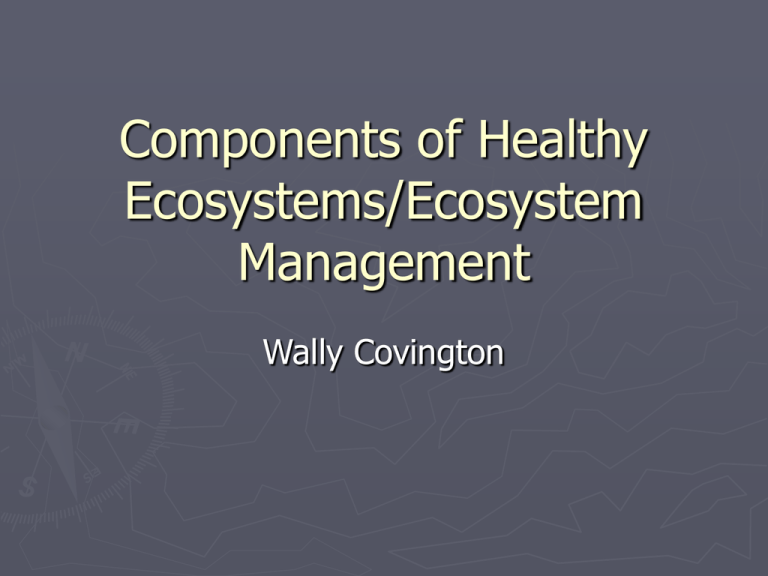Forest Ecology and the Forest Ecosystems
advertisement

Components of Healthy Ecosystems/Ecosystem Management Wally Covington Ecosystem Studies ► Ecosystem studies based on general systems principles focus on the movement of energy, nutrients, water, organisms, etc. through landscape units called ecosystems An ecosystem: What is it? ► Size? Can be as large or small as needed to fit the purpose of study ►A single leaf ► A forested stand ► A watershed ► Hierarchical units Definitions: ► Watershed: topographically defined unit of land, all precip. flows out of a single stream ► Stand: any area of forest vegetation whose site conditions, past history, and current species composition are sufficiently uniform to be managed as a unit A watershed can have many stands Ecosystem Study Examples – Hubbard Brook ► Ecosystem-level study of a forested watershed ► Hubbard Brook Valley; Durham, NH ► Six small watersheds with similar geology, soils, and vegetation Ecosystem Study Examples – Hubbard Brook ► Watershed: topographically defined unit of land, all precip. flows out of a single stream ► Monitor: precipitation in (rain gauges) streamflow out (weir) nutrients in: ► Plants, soil, and those lost in water Ecosystem Study Examples – Hubbard Brook ► 1. Study paired watershedecosystem before a disturbance ► 2. Then disturb the system ► 3. Compare inputs and outputs before and after (In this case, forest harvesting practices such as a clear-cut = treatement) (or use “paired watersheds” – one disturbed, other not) ► 4. Differences in water, nutrients, etc. – due to the treatment Organic Budgets/Nitrogen Cycle ► ► ► ► Very different in deciduous vs. coniferous forests Decomposition – (therefore, release of nitrogen in ionic form) is often faster in deciduous forests Coniferous trees need less nitrogen/decomposition is often slower Fire can be important in mobilizing nitrogen Computer Models: Central to Ecosystem Management ► Need computer models: Complexity of forest ecosystems Complexity of management decisions What is a model? ► Model = an abstract ► representation of a system or process Formulated in many different ► Physical models ways – reduced size; model airplanes or model buildings Better visualize Better understand the forces ► Abstract models - use symbols and equations: Verbal, graphical, and mathematical models Ecosystem Management ► The ecosystem approach: healthy ecosystems and sustainable economies a method for sustaining or restoring natural systems and their functions and values goal driven, and it is based on a collaboratively developed vision of desired future conditions that integrates ecological, economic, and social factors. applied within a geographic framework defined primarily by ecological boundaries. ► The goal of the ecosystem approach: restore and sustain the health, productivity, and biological diversity of ecosystems and the overall quality of life through natural resource management that is fully integrated with social and economic needs.






